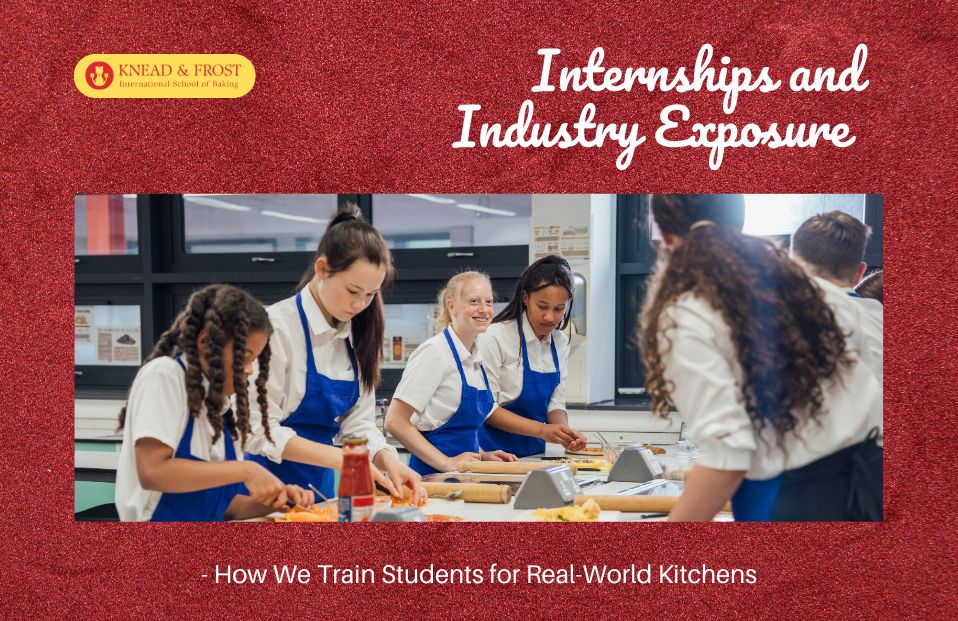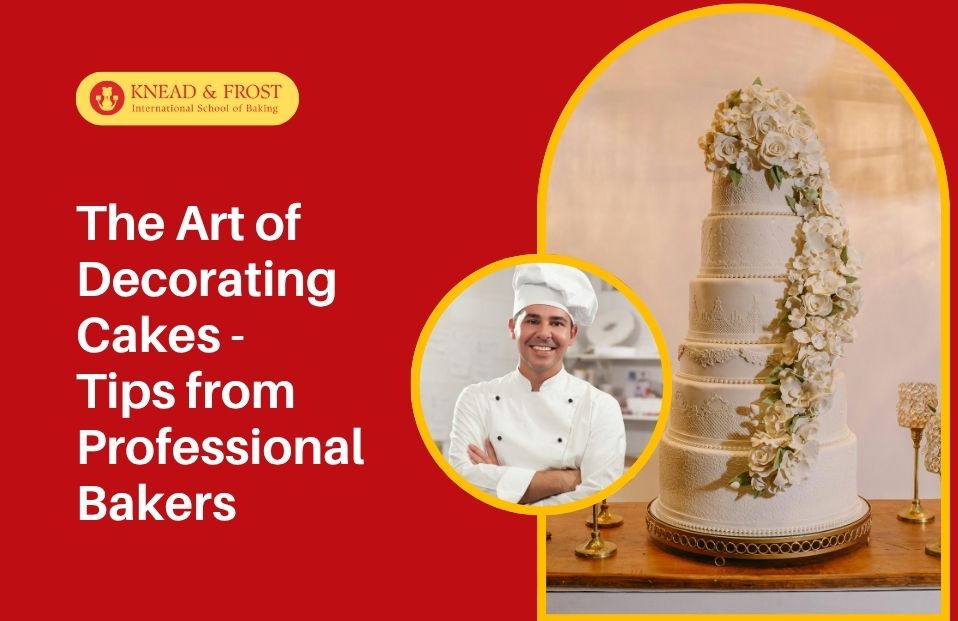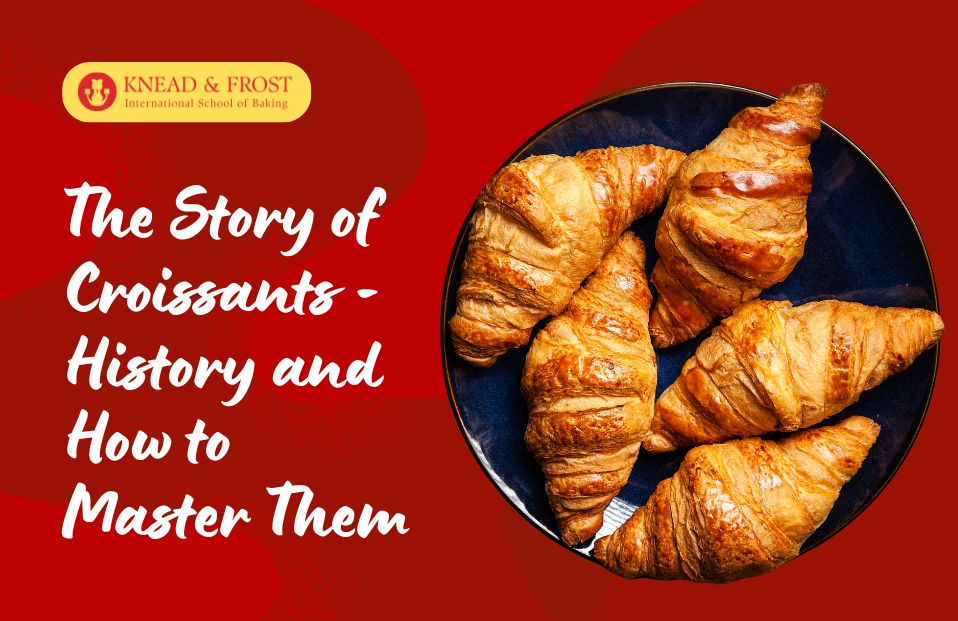When you think of croissants, what comes to mind?
For many, it is that golden, flaky pastry sitting beside a hot cup of coffee, the kind of breakfast that feels simple yet luxurious.
But behind every buttery bite lies a story that is as layered as the croissant itself. This pastry is not just food, it is history, culture, and craftsmanship rolled into one.
At Knead & Frost International School of Baking, we believe baking is about more than recipes. It is about stories, traditions, and the joy of creating something that connects people across generations and continents.
And the croissant, one of the world’s most loved pastries, is a perfect example of that.
A Journey Through History
Most people today think of croissants as purely French, but their story begins long before they became Paris’s breakfast staple. Their ancestor, the kipferl, was born in Austria. This crescent-shaped bread was made as far back as the 13th century. According to one popular legend, Viennese bakers created the pastry to celebrate victory over the Ottoman Empire. Its crescent shape reflected the symbol of the Ottomans, turning bread into a symbol of triumph.
So how did the kipferl travel to France?
In the 18th century, Austrian baker August Zang opened a bakery in Paris, introducing the French to Viennese specialties. The French bakers, known for their creativity, took the idea further.
They refined the dough, added more butter, folded it again and again, and eventually gave birth to the croissant we adore today – light, airy, and irresistibly flaky.
Isn’t it amazing how a single pastry carries centuries of culture and exchange within its folds?
What Makes a Perfect Croissant?
If you have ever torn apart a croissant and seen dozens of delicate layers, you know that making one is not simple. The secret lies in lamination, which means folding butter into dough several times. Each fold creates new layers, and when the pastry bakes, the butter releases steam, causing the dough to puff up beautifully.
But lamination is not just a technique, it is an art. The dough must be handled gently, kept cool, and given time to rest. Too much warmth, and the butter melts, ruining the layers. Too little patience, and the dough becomes heavy instead of airy. Have you ever wondered why bakery croissants often look picture-perfect, while homemade ones sometimes turn out flat? It’s usually because of this delicate balance of temperature and timing.
Can You Bake Croissants at Home?
The thought of making croissants at home might feel overwhelming, but with patience, it is entirely possible. Unlike quick breads or cookies, croissants take time. They demand care at every step, from kneading the dough to folding, resting, and proofing before baking.
It begins with good ingredients. A high-quality butter makes all the difference, as its flavour and fat content determine
the richness of the pastry. The dough must be kneaded until it’s strong enough to handle multiple folds. Then comes the challenge of folding butter into dough without melting it, which requires a cool workspace and steady hands. And finally, there is the waiting, letting the dough rest so that each layer develops properly.
When you finally slide them into the oven, the aroma fills your kitchen with pure comfort.
And that first bite into a croissant you made yourself? That is the reward for your patience. It is proof that some of the best things in life take time.
Beyond the Classic Croissant
Of course, croissants aren’t limited to their buttery original form. Over time, bakers have experimented and created delightful variations.
Almond croissants filled with sweet frangipane, chocolate croissants with melted richness inside, and even modern twists like cruffins and croissant-doughnuts show how versatile this pastry can be.
Think about it, how many foods manage to stay classic while also inspiring constant reinvention? That is the magic of the croissant. It honours tradition while leaving room for endless creativity.
Why Croissants Still Matter Today
Despite new dessert trends coming and going, croissants remain timeless. Part of their charm is that they’re not just something to eat, they are an experience. Tearing into a croissant forces you to slow down, feel the texture, and appreciate the layers of work that went into it. It is a small luxury that fits perfectly into everyday life.
At Knead & Frost, we often tell our students that baking croissants means baking history. Every fold is a nod to the bakers of Vienna and Paris. Every rise in the oven is proof of centuries of skill being passed down.
Isn’t it wonderful to think that when you enjoy a croissant, you are sharing in a tradition that stretches across countries and generations?
A Pastry with a Story
So, are croissants Austrian or French?
The truth is, they belong to the world. They are a piece of history you can hold in your hands, a mix of culture and creativity you can taste. And best of all, they are something you can learn to make yourself.
At Knead & Frost International School of Baking, we guide students through this journey step by step, teaching them not only how to bake croissants but also how to understand their story and the skill behind them.
Because baking a croissant is not just about flour and butter, it is about patience, care, and respect for a craft that has stood the test of time.
So, the next time you enjoy a croissant, take a moment to think of its journey.
From a humble Austrian kipferl to a French icon and now a global favourite, it is proof that food is never just food, it is history, culture, and love baked into every layer.



